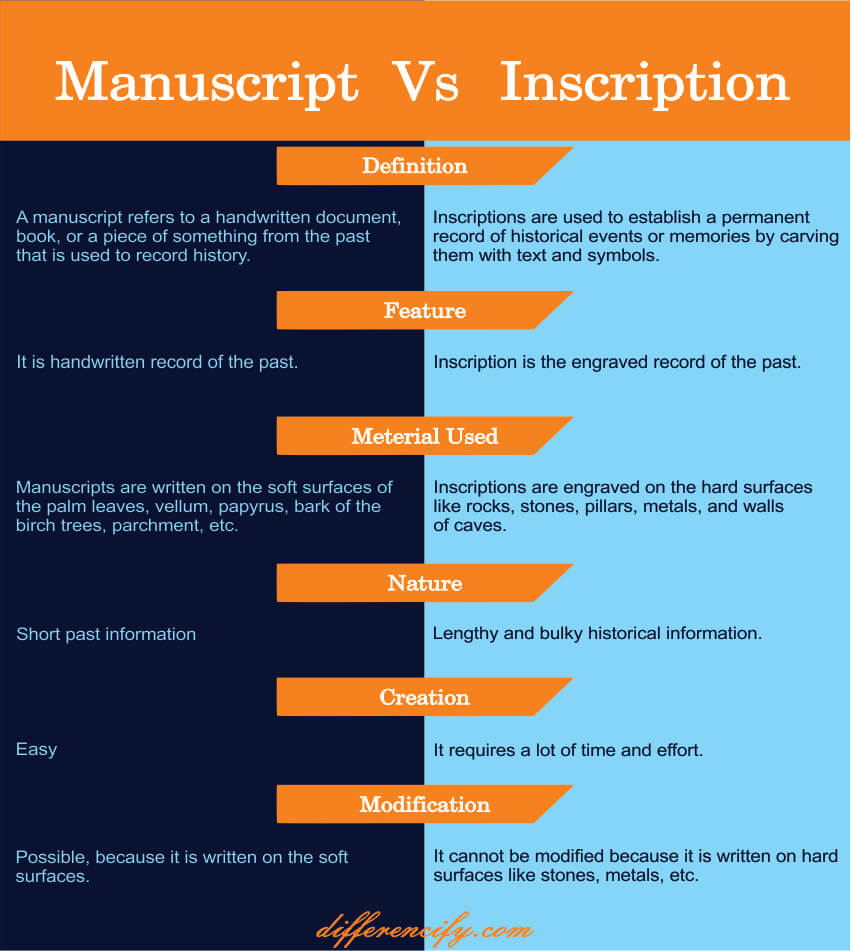An inscription is a type of engraving (an example of this is the Egyptian Book of the Dead) that has been carved or incised into a stone, metal, or other hard surfaces. A manuscript is a handwritten text that was produced from the 1st millennium AD to the end of the 15th century, typically on parchment, palm leaves, the bark of a tree, cloth, etc. These are different terms and have different meanings to them. So, in this article, we will get to understand the complete difference between manuscript and inscription.
You Can Also Read: Difference Between Sociology and Anthropology
What is a Manuscript?
A manuscript is a handwritten document. The word “manuscript” comes from the Latin word ‘’Manu scriptus’’ for “handwritten,”. Manuscripts were the only way to record and transmit information before the invention of printing in the 15th century.
Manuscripts are handwritten compositions that were used to record events, information, and memories in the history or past. They were written on palm leaves, tree bark, bamboo, ivory, and parchments. Writing is accomplished with a brush reed, pen, or colored fluid.
Palm leaves were sliced into pages, which were then joined together to form a booklet. They were the books of the past time.
Moreover, the manuscript contains data and information which tell us about the religious beliefs, cultures, rules and policies, lifestyle, customs, and traditions followed by the people during that(ancient) time. Manuscripts were difficult to preserve because paper does not last very long. Papyrus, for example, which was extensively used for numerous texts, had a lifespan of only a few centuries. Manuscript preservation was complicated by adverse weather conditions, storage, insect damage, and other factors.
Today, we use the term “manuscript” to refer to the text of a book, article, or other documents that have been submitted to a publisher for publication. In this context, a manuscript is equivalent to a typed document.
However, some writers still prefer to write their first drafts by hand. And some publishers will request that you submit a hand-written manuscript if they are considering your work for publication.
What is an Inscription?
An inscription is not written, but it is an engraved record of something in the past. It refers to any form of written communication that is preserved in a durable form. This can include anything from tombstones and other monuments to coins, caves, walls, rock surfaces, slabs, and seals. Inscriptions are generally considered to be more permanent than manuscripts, which are typically made of paper or other perishable materials.
Moreover, an inscription can be found on different things like a headstone, a coin, or even a wall. Before the invention of paper, people used to communicate through inscriptions on different materials like slabs, rock surfaces, and seals. Epigraphy is the field in which we study inscriptions. These are the most important and comprehensive sources of the country’s political, social, commercial, and economic history.
Types Of Inscriptions
- Dedicative Inscriptions: A dedicative inscription is an inscription that serves to dedicate a monument or other object to a particular deity, person, or group.
- Funerary Inscriptions: A funerary inscription is an inscription that is placed on a grave or tombstone in order to commemorate the deceased.
- Magical Inscriptions: A magical inscription is an inscription that contains a magical formula or spell.
- Memorial Inscriptions: A memorial inscription is an inscription that is placed on a monument or other object in order to commemorate a particular person or event.
- Literary Inscriptions: A literary inscription is an inscription that contains a piece of literature, such as a poem, poet, or play.
- Eulogistic Inscriptions: An eulogistic inscription is an inscription that praises or celebrates the subject of the inscription. It includes epitaphs, laudatory verses, and honorary titles.
Forms of Inscription
1. Epigraphs – These are short inscriptions, often just a word or phrase, carved on stone or metal. They are found on tombstones, monuments, buildings, coins, etc.
2. Graffiti – This is a more informal type of inscription, usually scratched or painted onto walls or other surfaces. It is often seen in public places like toilets, trains, and buses.
3. Petroglyphs – These are carvings or drawings made onto rocks and stone surfaces. They are usually found in caves and ancient ruins.
Manuscript Vs Inscription(Comparison Table)
The table will help you understand the complete comparison between manuscript vs inscription.

Five Key Differences Between Manuscript and Inscription
The six key differences between manuscript and inscription are as follows:
- The manuscript is written on dried palm tree leaves, dried sheep skin, or birch tree bark, whilst inscriptions can be found on stones, pillars, tombs, and caves. For example, the ruler’s or kings’ engrave inscriptions.
- Manuscripts are less difficult to compose. On the other hand, inscriptions required a significant amount of time and work to create.
- While Manuscripts can be made on a variety of materials like paper, parchment, dried leaves of palm trees, the skin of an animal, etc., inscriptions are usually carved on stones, slabs, rock surfaces, bricks, metal, etc.
- Manuscripts are usually created for personal use. On the contrary, inscriptions are meant for public display.
- Manuscripts can be edited and revised while inscriptions are permanent once they’re created.
- The style of writing in manuscripts can be varied depending on the author’s preference, while the style of the inscription is more limited and standardized.
Conclusion
From the above discussion, it is clear that there are some key distinctions between manuscripts and inscriptions. Manuscripts are usually written on paper or parchment, while inscriptions are typically carved into stone or metal. Manuscripts can be created by anyone with a writing utensil, while inscriptions usually require some form of engraving tool. Finally, manuscripts can be erased and rewritten, while inscriptions are permanent.




2 Comments